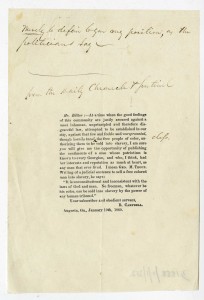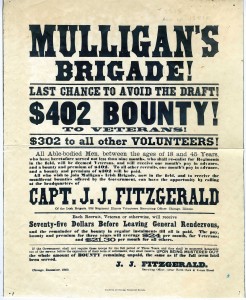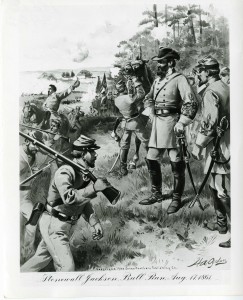Irish voices from the American Civil War
Published in Emmigration, Features, Issue 6 (November/December 2015), Volume 23ARCHIVES RELATING TO SLAVERY AND THE AMERICAN CIVIL WAR HELD IN THE PUBLIC RECORD OFFICE OF NORTHERN IRELAND (PRONI)
By Brett Irwin
The majority of the records in the PRONI relating to the American Civil War are letters sent to Ireland from people who witnessed slavery and the conflict at first hand. In my research I found many interesting archives relating to the conflict, and some of the letters were particularly revealing regarding the situation and attitudes of that time. They contain insights into the war and views on slavery from New York to Belfast and from Georgia to Antrim. I found letters for and against slavery, on the effects of the first shots fired, accounts of battles, and documents relating to notable figures during the war with an Irish and Ulster-Scots background.
Slavery
In a letter to relatives in Ballymoney, Co. Antrim, dated 31 May 1854, William McElderry of Lynchburg, Virginia, seeks to justify slavery with biblical references and the support of newspaper editors:
‘The Bible recognises slavery. The institution existed among the Jews in the day of our saviour, did he who continually reproach sin ever say anything against slavery.’
He goes on to mention a northern Irish newspaper editor who defends slavery:
‘Sometime ago I subscribed to The Citizen, a paper published and edited by John Mitchell in New York. The first charge I see brought against him for his truculent defence of slavery. How little they know of what they are talking of, coming from New York and defending slavery is very much like going to Rome and fighting with the Pope. He has, of course made himself unpopular with northern people in the United States’ (T2414/13).
In contrast, in a fascinating letter sent by R. Campbell of Georgia to a John Campbell of Belfast on 10 January 1860 there is a strong condemnation of slavery from a ‘Georgia patriot’, published in the state’s Daily Chronicle and Sentinel newspaper:
‘It is unconstitutional and inconsistent with the laws of God and man. No freeman, whatever be his color, can be sold into slavery by the power of any human tribunal’ (D1558/1/131).
This was not what I expected to find when reading letters about slavery and it contradicts traditional views of the attitudes held in the northern and southern states. I also find it curious and interesting that the Bible is used both to justify and to condemn slavery.
Fort Sumter
Major Robert Anderson, the Union commander of Fort Sumter in Charleston Harbour, South Carolina, issued a warning to President Lincoln on 5 March 1861, stating that they had less than six weeks’ food supplies left and that the fort needed to be resupplied, as tensions and conflict with the Confederacy were looking increasingly likely. Lincoln attempted to resupply the fort, but found the Confederacy demanding the total evacuation of Union soldiers or they would fire upon it. At 4.30am on 12 April 1861, 43 Confederate artillery pieces began bombarding the fort and the bloodiest war on American soil began. In a revealing letter from Private John Thompson, 1st US Artillery, to his father, Robert Thompson of Articlave, Co. Londonderry, on 28 April 1861, we have an actual account of the start of the war and the assault on Fort Sumter:
‘At 3 o’clock we hoisted our colours the glorious Star Spangled Banner and quietly awaited the enemies fire. Long before daylight, at 4.30am, the first shell came hissing through the air and burst right over our heads. The thrill that ran through our veins at this time was indescribable . . . The damage done to our fort was considerable. Our quarters were knocked into a cocked hat and had been three times on fire from the bursting of shell.’
John mentions the surrender of the fort to the Confederates at the end of the letter:
‘At the rebel gentlemen’s request the white flag was shown from our ramparts and the firing ceased. As soon as all was quiet the flag of truce was hauled down, and our commander submitted his terms; which were that we should leave with the honours of war, salute our flag and be furnished with transportation anywhere north we desired’ (T1585/2).
This letter really captures the feeling of excitement experienced by a young man in his first taste of war. It describes the momentous event that the attack on Fort Sumter became in the history of the American nation. The Confederates are described as the ‘rebel gentlemen’. This view of the enemy is common and is found in letters throughout the conflict; although they were adversaries, there is much more of a sense of commonality and courtesy in addressing each other than in other wars of the nineteenth century.
Antietam
The Army of the Potomac, under the command of Union General George McClelland, mounted a series of powerful assaults against Confederate General Robert E. Lee’s forces near Sharpsburg, Maryland, on 17 September 1862. This became known as the Battle of Antietam and was the first major battle fought on Union soil. On 17 September 1862, Andrew Greenlees of Michigan wrote to his brother in Magheramorne, Co. Antrim:
‘At the great battle of Antietam, Maryland, the rebels were fairly defeated, fleeing in all directions to get into Virginia and yet General McClelland never moved after them, not till they were all safe and sound cross the river’ (T2046/11).
Although historians agree that this battle ended in a tactical draw, it was perceived as a victory for the Union army, and the criticism of McClelland for being too cautious was to see him removed from command. In another letter from 1864, William McFarland, a native of County Antrim, is writing to his brother in Philadelphia and telling him of his war experiences while serving in the Union army:
‘Richmond the Rebel Capitol—I was there during the siege under McClelland that forms a part of my adventures on the Chickahoming River . . . Dear Brother I faiced [sic] death on the edge of all those battle fields’ (D732/1).

Views on slavery were not necessarily determined by geography. A ‘Georgia patriot’ condemns the sale of ‘free people of color’ into slavery in a letter to the state’s Daily Chronicle and Sentinel newspaper. (PRONI)
General Stonewall Jackson
General Thomas J. ‘Stonewall’ Jackson’s ancestral home was the Ballinary/Birches area of County Armagh, near the shore of Lough Neagh. A plaque unveiled by the United States Consul General in 1968 states that ‘This was the birthplace of John Jackson, great grandfather of Thomas “Stonewall” Jackson’. Today there are reportedly more Jacksons living in this part of County Armagh than in any other region of Northern Ireland. When the Civil War broke out in April 1861, Thomas Jackson was commissioned a colonel in the Confederate army. He led a detachment of Virginia Military Institute cadets from Lexington to Richmond to defend the Confederate flank there. This led to the command of the Virginia forces at Harper’s Ferry and placed him on the front line. Jackson distinguished himself at the Battle of Bull Run in July 1861 and was instrumental in inflicting a crushing defeat on the Union army. His bravery was such that General Bernard E. Bee, commander of the South Carolina Confederacy, exclaimed: ‘There he stands like a stone wall. Rally behind the Virginians.’ General Bee would die in this battle but the ‘stone wall’ tribute would become legend.
On 2 May 1863, Jackson was accidentally shot by men of the 18th North Carolina Infantry Regiment in what in modern military terms would be called a ‘friendly fire’ incident. He died on 10 May, aged 39, and his last words are reported to have been: ‘Let us cross the river and rest under the shade of the trees’. These last words underline his abiding Christian faith. General Robert E. Lee commented that ‘I know not how to replace him’, and President Lincoln described him as ‘a very brave soldier’ even though he was on the opposing side.
Other American Civil War generals who had Irish and Ulster connections include George McClelland, Irvin McDowell, Ambrose Burnside, David Gregg, Philip Sheridan and James Shields in the Union army, and Joseph Johnston, Albert Johnston, Daniel Donelson, Leonidas Polk and Jeb Stuart for the Confederacy.

‘Lay me down and save the flag’—the last order of Col. James A. Mulligan after he was mortally wounded at the Second Battle of Kerntown, Winchester, Virginia, 23 July 1864. (PRONI)
Colonel Mulligan
James A. Mulligan was a colonel in the 23rd Illinois Volunteer Infantry Regiment of the Union army. On 20 February 1865 the United States Senate confirmed his posthumous promotion to the rank of brigadier general, to date from 23 July 1864, the day before he was mortally wounded at the Second Battle of Kernstown, Winchester, Virginia. He commanded the federal forces at the First Battle of Lexington, Missouri, and fought with distinction in other engagements in the eastern theatre prior to his death.
On 3 July 1864 Colonel Mulligan distinguished himself in the Battle of Leetown, fought in and around Leetown, Virginia, between Union Major-General Franz Sigel and Confederate Major-General Jubal Early. Late in the afternoon of 24 July, a large Confederate force attacked Mulligan’s 1,800 soldiers from the church. His men fought bravely, but devastating Confederate flank attacks from the east and west encompassed Mulligan’s small force and he ordered his troops to withdraw. Confederate snipers managed to hit Mulligan. His troops endeavoured to carry him to safety but came under heavy, concentrated, fire from the Confederates. Aware of the danger his troops faced, Mulligan issued his famous order: ‘Lay me down and save the flag’. His men reluctantly agreed. The Confederates captured Mulligan and carried the mortally wounded colonel into a nearby home, where he died two days later.

Confederate General Thomas J. ‘Stonewall’ Jackson’s ancestral home was in the Ballinary/Birches area of County Armagh, near the shore of Lough Neagh. (PRONI)
The archives
In the archives at the PRONI we have read extraordinary views on slavery, north and south, and accounts of the first shots fired at Fort Sumter, of the Battle of Antietam and of the siege of Richmond. Images relating to American Civil War officers with Irish and Ulster connections who fought on both sides complement the letters and help us to commemorate the ending of the American Civil War 150 years ago. All of these American Civil War sources can be found in the archives at the Public Record Office of Northern Ireland and are open to the public.
All the material presented here was used with the permission of the Deputy Keeper of Records, PRONI.
Brett Irwin is an archivist at the Public Record Office of Northern Ireland.
Read More:
















